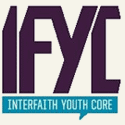By Sana Saeed
DIGITAL SUPPORT FOR INTERFAITH RELATIONSHIPS
Happy Black History month! TIO’s theme this month is new models of interfaith community. So it seems appropriate to explore different social media platforms supporting interfaith engagement, particularly with the younger generation. These five resources are the tip of the iceberg in terms of new social media platforms. But they are the most popular, free, and accessible social media resources, providing good ways to start for anyone exploring social media platforms.
YouTube – YouTube is a popular video-sharing website where users can upload, view, and share their videos. Founded in 2005, it has become popular with organizations and causes as a way to get out the word with promotional videos and public service announcements. An excellent example is Project Interfaith USA, which uses YouTube in a video-sharing project called RavelUnravel. It allows people to share their personal religious or spiritual stories, confront stereotypes, and learn about the diversity within religions and belief systems.
RavelUnravel started in July 2010, putting a call out for volunteers to serve as interviewers. Ultimately they chose 35 interviewers, ranging from 20 to 80 years old and belonging to 14 different religious and spiritual identities. More than 720 video interviews representing diverse people of faith and non-faith have been posted.

Blog Talk Radio – Blog Talk Radio is the world’s largest social radio network. The idea with this platform is to empower people to become their own radio hosts and produce their own shows. You can easily set up a radio show by following this guide by Blog Talk Radio. It lists how to attract a following, how to make a show attractive to followers etc… An excellent example of an interfaith Blog Talk Radio show is the Open Minds Open Hearts, a progressive interfaith radio show broadcasted on Monday nights at 8:00pm on their Blog Talk Radio channel. Open Minds Open Hearts highlights the commonalities that diverse faiths share through interviews and coverage of interfaith events and conferences.
Another interesting show is Real Revolution, founded by a group of Ahmaddiya Muslims to highlight what’s going on in the Muslim community by using comic relief. They’ve become so successful that they now broadcast from a station, WLIE 540 AM. You can listen live on Friday nights at 7 PM EST either with your radio or through the internet at www.wlie540am.com.
Twitter – Twitter is an online social networking service and microblogging service that enables users to send and read text-based messages of up to 140 characters, known as “tweets.” There are a number of ways to use twitter. You can set up a personal account for yourself or for your organization and keep followers updated on new changes, online petitions, and other things that you’d like to get them involved in. Here is a guide book on using twitter. My favorite way to use Twitter is through engaging my followers and others in Twitter chats. More recently, I’m helping to moderate a chat called #DCFaith, which is pre-conference chat to engage Twitter users in an upcoming DC Faith Leaders Summit organizing a hundred 18-35 year old youth and young adults to tackle the challenges of engaging our generation in interfaith activism.
Co-hosts of the #DCFaith chat included the Interfaith Alliance, Susan Katz Miller of Being Both, The Interfaith Observer (TIO), Interfaith Youth Activist and Faith in Action, DC. 5 Steps to Hosting a Successful Twitter Chat: Your Ultimate Guide by Ann Smarty is the most helpful beginners guide to figuring out the steps in hosting a chat. Why a Twitter Chat? Because, you increase your followers, build connections by having live interfaith dialogue with individuals and organizations, and you can think of creative ways to use the information you have aggregated through tweets into an interfaith project, like publishing a book or creating a service project. This is also a helpful way to learn about what changes you can make to your own interfaith projects.

Facebook – Facebook, as most folks already know,is a social utility that connects people with friends and others who work, study and live around them. But you may not know all the interesting options it offers. People can create individual profiles, then go on to create community pages or groups for their interfaith organization or project. Interfaith Youth Core has about 6,841 ‘likes’ currently and posts updates about new youth focused campaigns and service projects focused on interfaith activism. Here’s a guide to getting started on Facebook.
Facebook is the world’s largest social network, with more than 900 million users – more than Twitter. You can also market and advertise your page by selecting the demographics you’d like to attract to ‘like’ your page. Zenceo is an example of a Facebook Page that began by targeting particular demographics initially and then grew more followers naturally. They now have 24,945 ‘likes.’ The founder of this page is also an organizer for the annual Buddha Fest in Washington DC.
Blogging –Blogging is an interactive form of publishing content on the web. It comes from the term “web log.” Blogging dates back to the late 1990s and has become a dominant way of self-publishing in the 2000s. Here’s a great ‘how to’ guide by Problogger about getting started as a blogger and what blogging means today. Once you decide to create a blog, then you’ll have to choose a platform to host your blog.
My preference has been www.wordpress.com, but I’m also using tumblr.com for micro-blogging. Others have had great experience with http://www.blogger.com. Why blog? Susan Katz Miller explains in her blog post, Why Write an Interfaith Blog? There aren’t many blogs focused on interfaith families. She is often the first virtual voice tackling subjects about multifaith families. You can read her at On Being Both.
So, the question now is to invest in social media or not for interfaith engagement purposes? The Berkeley Center for Religion, Peace, and World Affairs has a great program called New Social Media Strategies advancing dialogue across faiths and cultures. The Center's report, entitled “Bridging Babel: New Social Media and Interreligious and Intercultural Dialogue” includes a survey of best practices, excerpts from interviews, and recommendations for taking advantage of new social media to promote greater understanding between religions and cultures. That might help you decide if social media is indeed the right route for you!
If you have any other suggestions, please feel free to email me at Sana. I’d be happy to share them on the TIO Facebook page.

